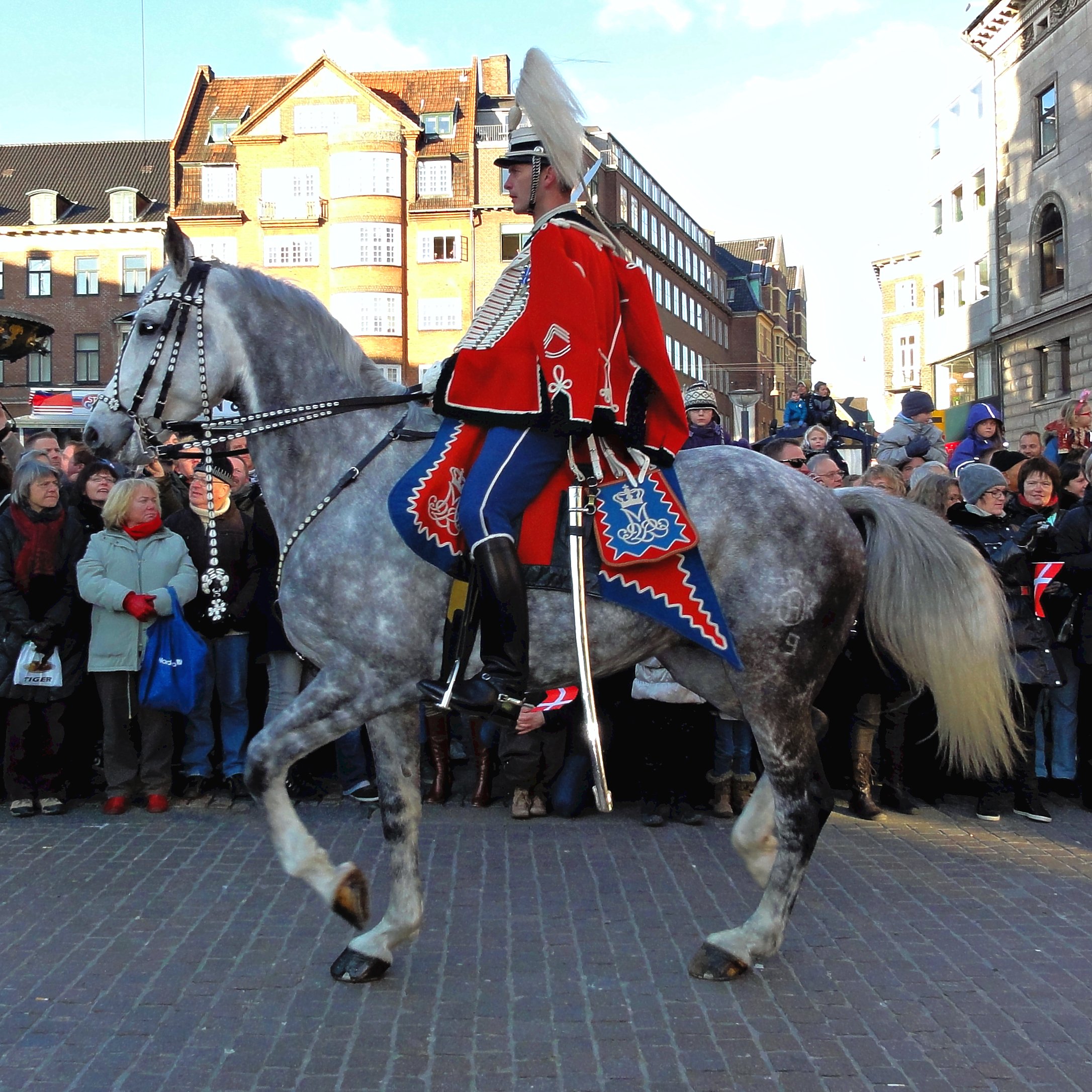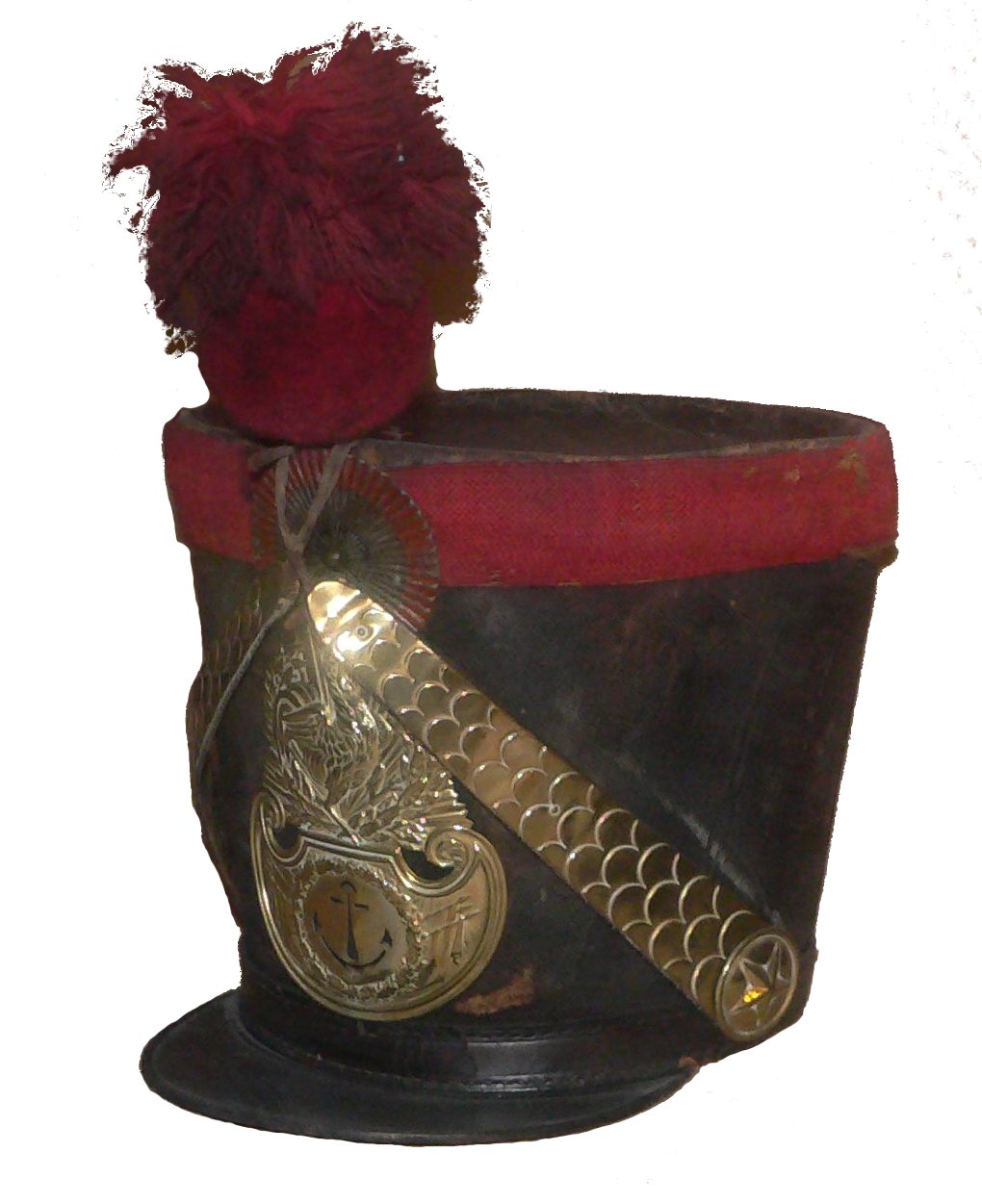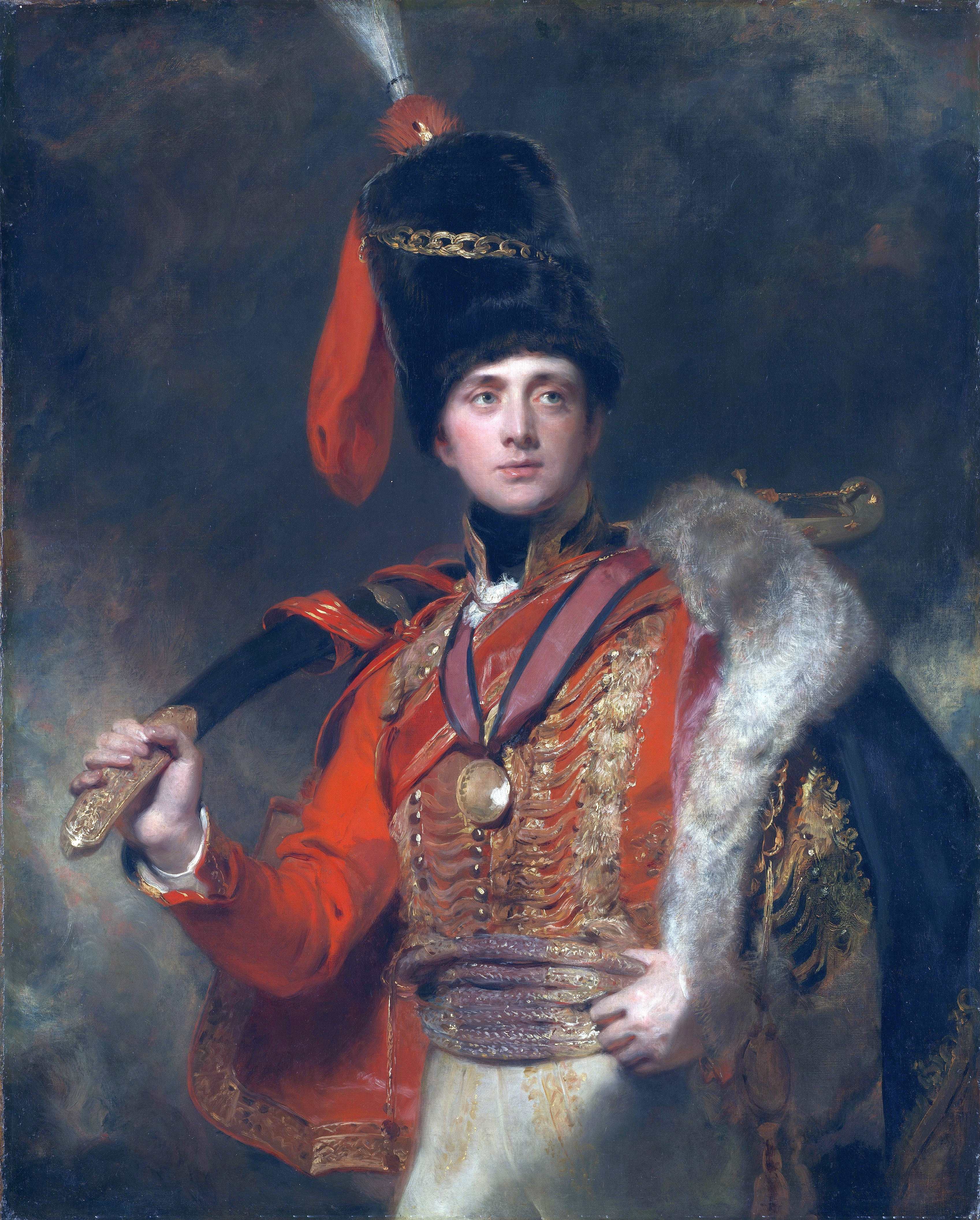|
Guard Hussar Regiment Mounted Squadron
The Guard Hussar Regiment Mounted Squadron ( da, Gardehusarregimentets Hesteskadron, HESK), is part of the Guard Hussar Regiment. The purpose of the squadron is to provide mounted escorts for the Royal family and carry ceremonial services for the Royal Danish Army. The squadron commands 75 horses, 18 officers and NCOs, and 75-100 conscripts. In addition it has a saddler, music-teacher, veterinarian, remount service and a farrier. History In 1762, there was a possibility of war between Denmark and Russia. The general staff was wary of the coming battle, due to the Cossacks, and Denmark's inability to counter the light cavalry. Inspired by the Hungarian hussars, Denmark created their own hussar regiment and adopted a similar uniform. Conscription The conscripts serve for 1 year, the longest time for a conscript in Denmark, with two troops starting each year, in February and August. It is also the only place where conscripts are issued silver monograms, all others regiments being ... [...More Info...] [...Related Items...] OR: [Wikipedia] [Google] [Baidu] |
Flag Of Denmark (state)
The national flag of Denmark ( da, Dannebrog, ) is red with a white Nordic cross, which means that the cross extends to the edges of the flag and the vertical part of the cross is shifted to the hoist side. A banner with a white-on-red cross is attested as having been used by the kings of Denmark since the 14th century."Dannebrog" by Hans Christian Bjerg, p.12, . An origin legend with considerable impact on Danish national historiography connects the introduction of the flag to the Battle of Lindanise of 1219. The elongated Nordic cross reflects its use as a maritime flag in the 18th century. The flag became popular as a national flag in the early 16th century. Its private use was outlawed in 1834 but again permitted by a regulation of 1854. The flag holds the world record of being the oldest continuously used national flag. Description In 1748, a regulation defined the correct lengths of the two last fields in the flag as . In May 1893 a new regulation to all chiefs of polic ... [...More Info...] [...Related Items...] OR: [Wikipedia] [Google] [Baidu] |
Troop
A troop is a military sub-subunit, originally a small formation of cavalry, subordinate to a squadron. In many armies a troop is the equivalent element to the infantry section or platoon. Exceptions are the US Cavalry and the King's Troop Royal Horse Artillery where a troop is a subunit comparable to an infantry company or artillery battery. Historically the remainder of the Royal Horse Artillery used the term Troop in the same manner however they are now aligned with the rest of the Royal Regiment of Artillery in referring to Troops as subordinate to artillery batteries. Troops is often used to refer to the other members of one's company or cause, but because of its military connotations, it conveys a particularly altruistic type of dedicated worker. Traditionally, troops refers to the soldiers in a military. A cavalry soldier of private rank is called a trooper in many Commonwealth armies (abbreviated "Tpr", not to be confused with "trouper"). A related sense of the ... [...More Info...] [...Related Items...] OR: [Wikipedia] [Google] [Baidu] |
Shabraque
A shabrack or shabraque ( tr, çaprak, hu, csábrák) is a saddlecloth, formerly used by European light cavalry. The shabraque was an accoutrement of the hussar cavalry, based on the Hungarian horsemen in Austrian service who were widely imitated in European armies in the 18th and 19th centuries. The shabraque was a large cloth which in its original form, covered the Hungarian-style saddle, and was itself surmounted by a sheep or goat skin. The corners of the shabraque were rounded at the front and elongated into long points at the rear. It could be elaborately decorated with a contrasting border and a royal cypher or regimental crest. It was often discarded while on active service and by the start of the 20th century, was confined to ceremonial use; in the British Army, it is used by the Household Cavalry and by General Staff officers.Kannik, Preben (1967) ''Military Uniforms of the World in Colour'', Blandford Press Ltd, (p. 268) See also * Caparison A caparison is a ... [...More Info...] [...Related Items...] OR: [Wikipedia] [Google] [Baidu] |
Drum And Bugle Corps (classic)
Classic (or "Golden Age") drum and bugle corps are musical ensembles that descended from military bugle and drum units returning from World War I and succeeding wars. Traditionally, drum and bugle corps served as signaling units as early as before the American Civil War, with these signaling units having descended in some fashion from ancient drum and fife corps. With the advent of the radio, bugle signaling units became obsolete and surplus equipment was sold to veteran organizations (such as the Veterans of Foreign Wars and American Legion, two major organizers for classic drum corps). These organizations formed drum and bugle corps of civilians and veterans, and the corps performed in community events and local celebrations. Over time, rivalries between corps emerged and the competitive drum and bugle corps circuit evolved. The term "classic" is used for the purposes of this article to differentiate it from modern drum and bugle corps, using the time period of the establishme ... [...More Info...] [...Related Items...] OR: [Wikipedia] [Google] [Baidu] |
Tail (horse)
The tail of the horse and other equines consists of two parts, the dock and the skirt. The dock consists of the muscles and skin covering the coccygeal vertebrae. The term "skirt" refers to the long hairs that fall below the dock. On a horse, long, thick tail hairs begin to grow at the base of the tail, and grow along the top and sides of the dock. In donkeys and other members of ''Equus asinus'', as well as some mules, the zebra and the wild Przewalski's horse, the dock has short hair at the top of the dock, with longer, coarser skirt hairs beginning to grow only toward the bottom of the dock. Hair does not grow at all on the underside of the dock. The tail is used by the horse and other equidae to keep away biting insects, and the position and movement of the tail may provide clues to the animal's physical or emotional state. Tail carriage may also be a breed trait. Tails of horses are often groomed in a number of ways to make them more stylish for show or practical for w ... [...More Info...] [...Related Items...] OR: [Wikipedia] [Google] [Baidu] |
Pompom
A pom-pom – also spelled pom-pon, pompom or pompon – is a decorative ball or tuft of fibrous material. The term may refer to large tufts used by cheerleaders, or a small, tighter ball attached to the top of a hat, also known as a bobble or toorie. Pom-poms may come in many colours, sizes, and varieties and are made from a wide array of materials, including wool, cotton, paper, plastic, thread, glitter and occasionally feathers. Pom-poms are shaken by cheerleaders, pom or dance teams, and sports fans during spectator sports. Spelling and etymology *''Webster's Third New International Dictionary'' (1961) gives the spelling as "pompon." *The ''New Oxford American Dictionary'' (third edition, 2010) gives the spelling as "pom-pom." *The ''American Heritage Dictionary of the English Language'' (5th edition, 2011) gives the spelling as "pompom" or "pompon." *''Webster's New World College Dictionary'' (fourth edition) gives the spelling as "pompom." ''Pom-pom'', also ... [...More Info...] [...Related Items...] OR: [Wikipedia] [Google] [Baidu] |
Shako
A shako (, , or ) is a tall, cylindrical military cap, usually with a visor, and sometimes tapered at the top. It is usually adorned with an ornamental plate or badge on the front, metallic or otherwise; and often has a feather, plume (see hackle) or pompom attached at the top. Origins The word ''shako'' originated from the Hungarian name for the ''peak'', which Hungarian border soldiers ( ''Grenz-Infanterie'') added around 1790 to their previously visorless stovepipe-style hats. Originally these hats were part of the clothing commonly worn by shepherds, before being added to the uniform of the Hungarian hussar in the early 18th century. Other spellings include ''chako'', ''czako'', ''sjako'', ''schako'', ''schakot'' and ''tschako''. From 1800 on, the shako became a common military headdress worn by the majority of regiments in the armies of Europe and the Americas. Replacing in most instances the light bicorne, the shako was initially considered an improvement. Made of heavy ... [...More Info...] [...Related Items...] OR: [Wikipedia] [Google] [Baidu] |
Frederick V Of Denmark
Frederick V (Danish and Norwegian: ''Frederik V''; 31 March 1723 – 14 January 1766) was King of Denmark–Norway and Duke of Schleswig-Holstein from 6 August 1746 until his death in 1766. He was the son of Christian VI of Denmark and Sophie Magdalene of Brandenburg-Kulmbach. Although the personal influence of Frederick was limited, his reign was marked by the progress of commerce and trade, and art and science prospered under his reign. Unlike his parents who were deeply devoted to Pietism, Frederick grew into a hedonist. As regent, he took part in the conduct of government by attending council meetings, but he was afflicted by alcoholism and most of his rule was dominated by able ministers who were influenced by the ideas of the Age of Enlightenment. His ministers marked his reign by the progress of commerce and the emerging industry. They also avoided involving Denmark-Norway in the European wars of his time. Although Frederick V wasn't personally interested in cultural affai ... [...More Info...] [...Related Items...] OR: [Wikipedia] [Google] [Baidu] |
Sabretache
A sabretache (derived from german: Säbeltasche) is a flat bag or pouch, which was worn suspended from the belt of a cavalry soldier together with the sabre. Origins The sabretache is derived from a traditional Hungarian horseman's flat leather bag called a ''tarsoly''. Early examples have been found in the tombs of Magyar warriors from the 10th century Conquest of Pannonia. They were often strengthened and decorated with silver plates and would have contained fire-making tools and other essentials. Military use In the early 18th century, hussar cavalry became popular amongst the European powers, and a ''tarsoly'' was often a part of the accoutrements. The German name ''sabretache'' was adopted, ''tache'' meaning "pocket". It fulfilled the function of a pocket, which were absent from the tight fitting uniform of the hussar style. Part of the wartime function of the light cavalry was to deliver orders and dispatches; the sabertache was well suited to hold these. The large fron ... [...More Info...] [...Related Items...] OR: [Wikipedia] [Google] [Baidu] |
Breeches
Breeches ( ) are an article of clothing covering the body from the waist down, with separate coverings for each human leg, leg, usually stopping just below the knee, though in some cases reaching to the ankles. Formerly a standard item of Western world, Western men's clothing, they had fallen out of use by the mid-19th century in favour of trousers. Modern athletic garments used for English riding and fencing, although called ''breeches'' or ''britches'', differ from breeches. Etymology ''Breeches'' is a double plural known since c. 1205, from Old English , the plural of "garment for the legs and trunk", from the Indo-European root *bhrg- "break", here apparently used in the sense "divide", "separate", as in Scottish Gaelic briogais ("trousers"), in Breton bragoù ("pants"), in Irish bríste ("trousers") and brycan/brogau in Welsh. Cognate with the Proto-Germanic language, Proto-Germanic word ''*brōk-'', plural ''*brōkiz'', itself most likely from the Proto-Indo-European roo ... [...More Info...] [...Related Items...] OR: [Wikipedia] [Google] [Baidu] |
Edward VII
Edward VII (Albert Edward; 9 November 1841 – 6 May 1910) was King of the United Kingdom of Great Britain and Ireland and Emperor of India, from 22 January 1901 until his death in 1910. The second child and eldest son of Queen Victoria and Prince Albert of Saxe-Coburg and Gotha, and nicknamed "Bertie", Edward was related to royalty throughout Europe. He was Prince of Wales and heir apparent to the British throne for almost 60 years. During the long reign of his mother, he was largely excluded from political influence and came to personify the fashionable, leisured elite. He travelled throughout Britain performing ceremonial public duties and represented Britain on visits abroad. His tours of North America in 1860 and of the Indian subcontinent in 1875 proved popular successes, but despite public approval, his reputation as a playboy prince soured his relationship with his mother. As king, Edward played a role in the modernisation of the British Home Fleet and the reorganis ... [...More Info...] [...Related Items...] OR: [Wikipedia] [Google] [Baidu] |
Pelisse
A pelisse was originally a short fur-trimmed jacket which hussar light-cavalry soldiers from the 17th century onwards usually wore hanging loose over the left shoulder, ostensibly to prevent sword cuts. The name also came to refer to a fashionable style of woman's coat worn in the early-19th century. Military uniform The style of uniform incorporating the pelisse originated with the hussar mercenaries of Hungary in the 17th Century. As this type of light cavalry unit became popular in Western Europe, so too did their dress. In the 19th century pelisses were in use throughout most armies in Europe, and even some in North and South America. In appearance the pelisse was characteristically a very short and extremely tight fitting (when worn) jacket, the cuffs and collar of which were trimmed with fur. The jacket was further decorated with patterns sewn in bullion lace, often in a pattern matching that of the dolman worn beneath it. The front of the jacket was distinctive and typica ... [...More Info...] [...Related Items...] OR: [Wikipedia] [Google] [Baidu] |








.jpg)
